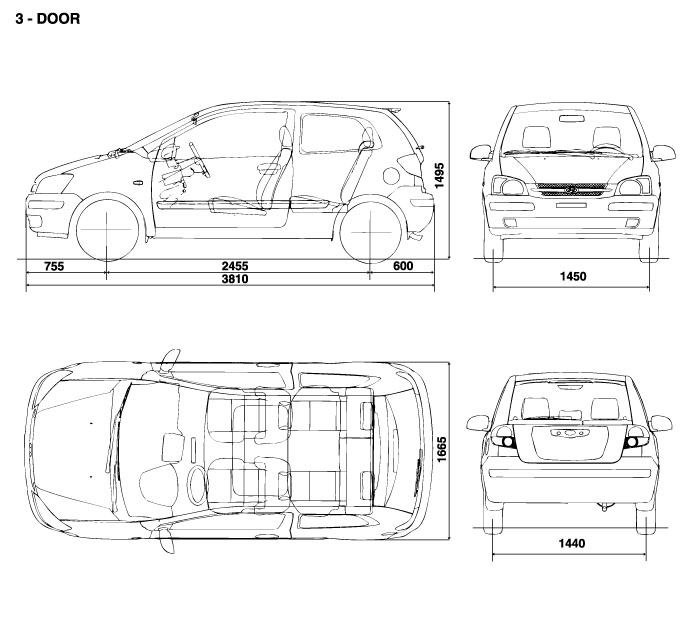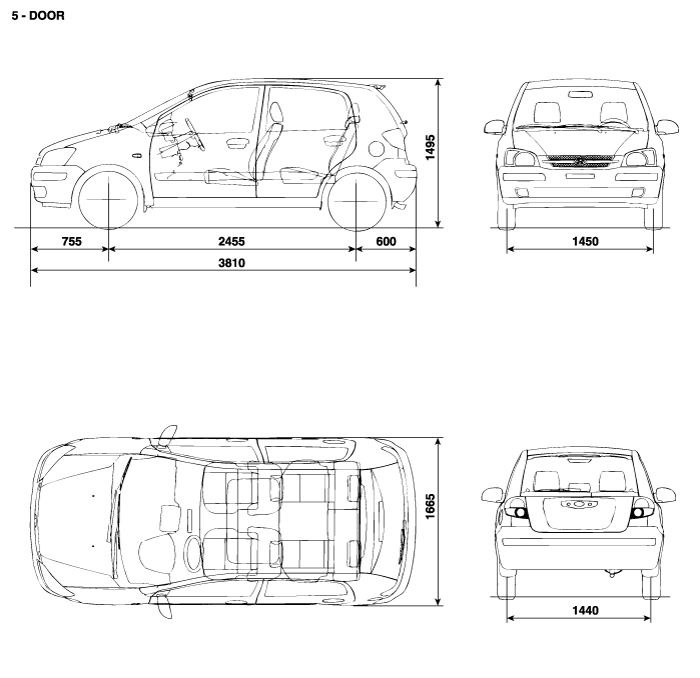Raise the hoist to full height to inspect the lift points for secure support.
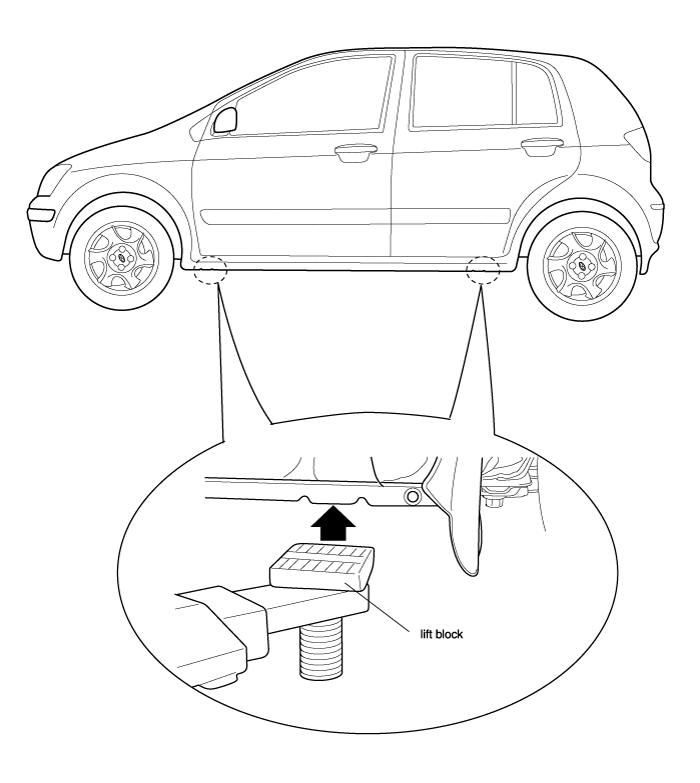
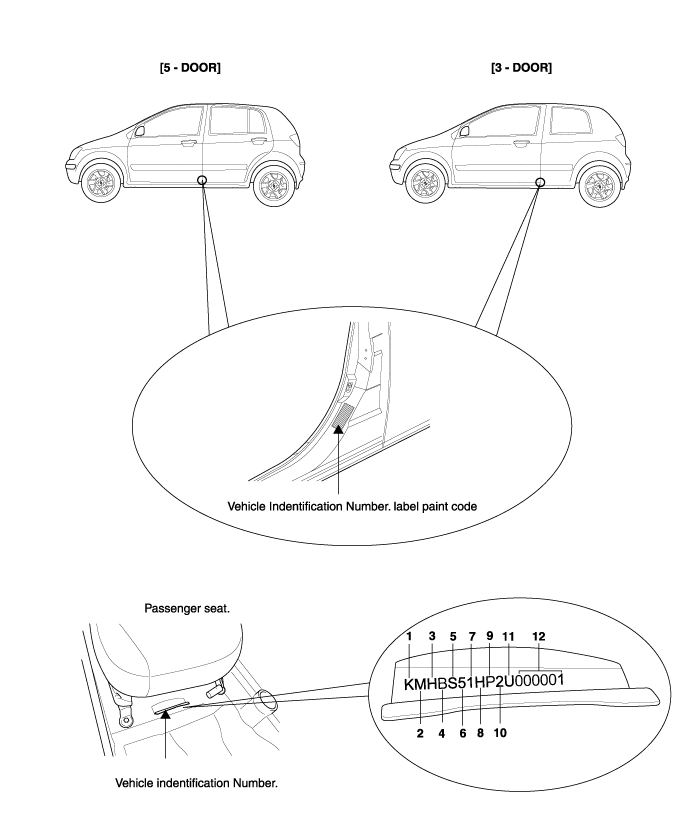
Geographic zone
K : Korea
Manufacturer
M : Hyundai motor company
Vehicle line
H : Passenger
Vehicle line
B : GETS
Model & Series
S : STANDAD (L)
T : DELUXE (GL)
U : SUPER DELUXE (GLS)
Body type
3 : Sedan 3 - Door
5 : Sedan 5 - Door
Restraint system
1 : Active belt (Driver side + Passenger side)
2 : Passive belt (Driver side + Passenger side)
3 : Driver side - Active belt + Airbag
4 : Driver side & Passenger side - Active belt + Airbag Passenger side - Active belt or passive belt
Engine type
A : Gas 1.5 DOHC
B : Gas 1.6 DOHC
G : Gas 1.1 SOHC
H : Gas 1.3 SOHC
Driver side
P : LHD, R : RHD
Production year
2 : 2002, 3 : 2003, 4 : 2004, 5 : 2005
Plant of production
U : Ulsan (Korea)
Vehicle production sequence number
000001 ~ 999999
CODE | COLOR |
NW | Noble White |
EB | Ebony Black |
CS | Clean Silver |
HL | Hiphop Red |
IA | Vivid Yellow |
YA | Potomac Bule |
UG | Green Been |
XU | Sea Side Blue |
WO | Lilac Blue |
TI | Tundra Green |
VS | Celadon Blue |
WS | Technical Gray |

Engine fuel
G : Gasoline
Engine range
4 : In line 4 cycle 4 cylinder
Engine development order
E : Alpha engine
H : Epsilon engine
Engine capacity
A : 1341 cc
D : 1085 cc (Epsilon engine), 1599 cc (Alpha - engine)
Production year
X : 1999, Y : 2000, 1 : 2001, 2 : 2002, 3 : 2003, 4 : 2004
Engine production sequence number
000001 ~ 999999
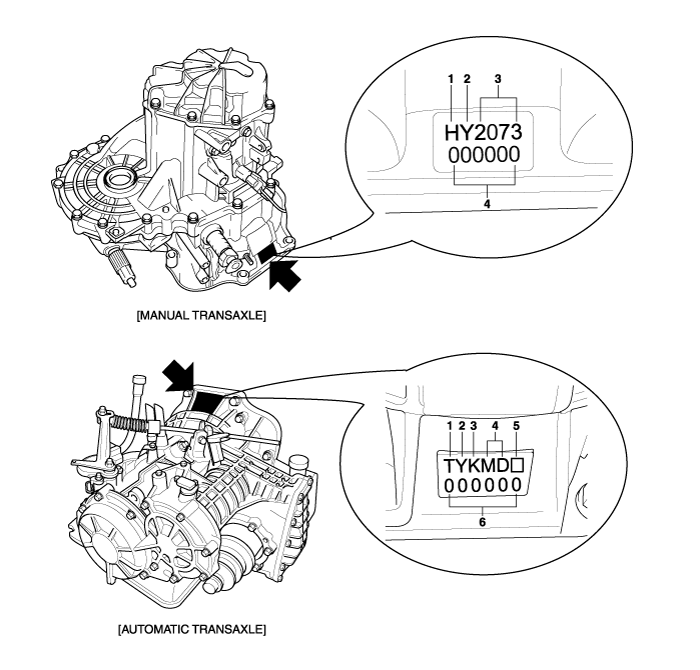
Model
H : M5AF3
Production year
W - 1998, X - 1999, Y - 2000, 1 - 2001,
2 - 2002, 3 - 2003, 4 - 2004, 5 - 2005
Gear ratio
2073 : 3.650
Transaxle production sequence number
000000 ~ 999999
T : A4AF3
Production year
W - 1998, X - 1999, Y - 2000, 1 - 2001,
2 - 2002, 3 - 2003, 4 - 2004, 5 - 2005
Gear ratio
K : 3.443
L : 3.656
Detailed classification
MD : 1.5 DOHC
ND : 1.3 SOHC
OD : 1.6 DOHC
Spare
Transaxle production sequence number
000000 ~ 999999
Place the lift blocks under the support points as shown in the illustration.
Raise the hoist a few inches and rock the vehicle to be sure it is firmly supported.
Raise the hoist to full height to inspect the lift points for secure support.

Never tow the vehicle by the method of a suspension (front or rear) lift.

The radiator lower member is not equipped to the vehicle. So, the vehicle's cooling system including radiator and condenser, under cover and front bumper can be damaged.
The towing hook is located in the right inside of the front bumper. There is no support point for a sling - type equipment.
There is no engine center member and suspension frame in the vehicle.
With manual transaxle
Release the parking brake.
Shift the transaxle in neutral.
With automatic transaxle
Release the parking brake.
Start the engine.
Shift to P position, then N position.
Turn off the engine.
Front wheel - lift towing is required.
It is best way to tow the vehicle no farther than 25 Km / h, and keep the speed below 40Km / h.
If you cannot shift the transaxle or start the engine, the vehicle must be transported on a flat - bed truck.
Trying to lift or tow the vehicle by the bumpers will cause serious damage.
BOLT (Nominal diameter) | NUT (Nominal diameter) | ||
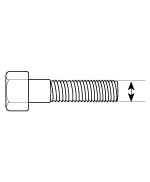 |  |
BOLT/NUT Thin screw | Torque Nm (kg.m, Ib-ft) | |||
Nominal diameter. (mm) | Pitch [mm (in.) ] | 4T | 8T | 10T |
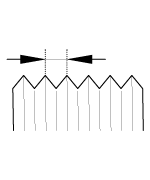 | 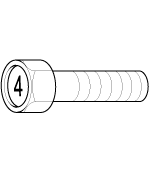 | 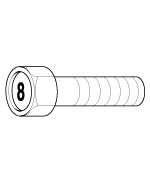 |  | |
M5 | 0.8 (0.031) | 2.0 ~ 3.0 (0.2 ~ 0.3, 1.4 ~ 2.2) | 4.9 ~ 6.9 (0.5 ~ 0.7, 3.6 ~ 5.1) | 7.8 ~ 10.8 (0.8 ~ 1.1, 5.8 ~ 8.0) |
M6 | 1 (0.039) | 2.9 ~ 4.9 (0.3 ~ 0.5, 2.2 ~ 3.6) | 8.8 ~ 12.7 (0.9 ~ 1.3, 6.5 ~ 9.4) | 13.7 ~ 18.6 (1.4 ~ 1.9, 10.1 ~ 13.7) |
M8 | 1.25 (0.049) | 8.8 ~ 11.8 (0.9 ~ 1.2, 6.5 ~ 8.7) | 22.6 ~ 30.4 (2.3 ~ 3.1, 16.6 ~ 22.4) | 33.3 ~ 44.1 (3.4 ~ 4.5, 24.6 ~ 32.5) |
M10 | 1.5 (0.059) | 16.7 ~ 22.6 (1.7 ~ 2.3, 12.3 ~ 16.6) | 45.1 ~ 60.8 (4.6 ~ 6.2, 33.3 ~ 44.8) | 65.7 ~ 88.3 (6.7 ~ 9.0, 48.5 ~ 65.1) |
M12 | 1.75 (0.068) | 29.4 ~ 39.2 (3.0 ~ 4.0, 21.7 ~ 28.9) | 78.5 ~ 105.9 (8.0 ~ 10.8, 57.9 ~ 78.1) | 114.7 ~ 154.9 (11.7 ~ 15.8, 84.6 ~ 114.3) |
M14 | 2 (0.078) | 47.1 ~ 63.7 (4.8 ~ 6.5, 34.7 ~ 47.0) | 125.5 ~ 169.7 (12.8 ~ 17.3, 92.6 ~ 125.1) | 183.4 ~ 249.1 (18.7 ~ 25.4, 135.3 ~ 183.7) |
M16 | 2 (0.078) | 73.5 ~ 100.0 (7.5 ~ 10.2, 54.2 ~ 73.8) | 197.1 ~ 266.7 (20.1 ~ 27.2, 145.4 ~ 196.7) | 288.3 ~ 390.3 (29.4 ~ 39.8, 212.7 ~ 287.9) |
M20 | 2.5 (0.098) | 144.2 ~ 195.2 (14.7 ~ 19.9, 106.3 ~ 143.9) | 396.2 ~ 535.4 (40.4 ~ 54.6, 292.2 ~ 394.9) | 565.8 ~ 764.9 (57.7 ~ 78.0, 417.3 ~ 564.2) |
M24 | 3 (0.118) | 249.1 ~ 337.3 (25.4 ~ 34.4, 183.7 ~ 248.8) | 687.4 ~ 929.7 (70.1 ~ 94.8, 507.0 ~ 685.7) | 975.8 ~ 1320.0 (99.5 ~ 134.6, 719.7 ~ 973.6) |
M30 | 3.5 (0.137) | 499.2 ~ 674.7 (50.9 ~ 68.8, 368.2 ~ 497.6) | 1372.9 ~ 1858.4 (140.0 ~ 189.5, 1012.6 ~ 1370.7) | 1956.4 ~ 2647.8 (199.5 ~ 270.0, 1443.0 ~ 1952.9) |
BOLT/NUT Thin screw | Torque Nm (kg.m, Ib-ft) | |||
Nominal diameter. (mm) | Pitch [mm (in.) ] | 4T | 8T | 10T |
 |  |  |  | |
M5 | 0.5 (0.019) | 2.0 ~ 3.0 (0.2 ~ 0.3, 1.4 ~ 2.2) | 5.9 ~ 8.8 (0.6 ~ 0.9, 4.3 ~ 6.5) | 8.8 ~ 12.7 (0.9 ~ 1.3, 6.5 ~ 9.4) |
M6 | 0.75 (0.029) | 3.9 ~ 4.9 (0.4 ~ 0.5, 2.9 ~ 3.6) | 9.8 ~ 13.7 (1.0 ~ 1.4, 7.2 ~ 10.1) | 14.7 ~ 20.6 (1.5 ~ 2.1, 10.8 ~ 15.2) |
M8 | 1 (0.039) | 8.8 ~ 11.8 (0.9 ~ 1.2, 6.5 ~ 8.7) | 24.5 ~ 32.4 (2.5 ~ 3.3, 18.1 ~ 23.9) | 35.3 ~ 48.1 (3.6 ~ 4.9, 26.0 ~ 35.4) |
M10 | 1.25 (0.049) | 17.7 ~ 23.5 (1.8 ~ 2.4, 13.0 ~ 17.4) | 47.1 ~ 63.7 (4.8 ~ 6.5, 34.7 ~ 47.0) | 69.6 ~ 94.1 (7.1 ~ 9.6, 51.4 ~ 69.4) |
M12 | 1.25 (0.049) | 32.4 ~ 44.1 (3.3 ~ 4.5, 23.9 ~ 32.5) | 86.3 ~ 117.7 (8.8 ~ 12.0, 63.7 ~ 86.8) | 127.5 ~ 172.6 (13.0 ~ 17.6, 94.0 ~ 127.3) |
M14 | 1.5 (0.059) | 51.0 ~ 69.6 (5.2 ~ 7.1, 37.6 ~ 51.4) | 136.3 ~ 185.3 (13.9 ~ 18.9, 100.5 ~ 136.7) | 201.0 ~ 271.6 (20.5 ~ 27.7, 148.3 ~ 200.4) |
M16 | 1.5 (0.059) | 79.4 ~ 107.9 (8.1 ~ 11.0, 58.6 ~ 79.6) | 211.8 ~ 286.4 (21.6 ~ 29.2, 156.2 ~ 211.2) | 311.8 ~ 421.7 (31.8 ~ 43.0, 230.0 ~ 311.0) |
M20 | 1.5 (0.059) | 163.8 ~ 221.6 (16.7 ~ 22.6, 120.8 ~ 163.5) | 448.2 ~ 607.0 (45.7 ~ 61.9, 330.5 ~ 447.7) | 639.4 ~ 864.9 (65.2 ~ 88.2, 471.6 ~ 638.0) |
M24 | 2 (0.078) | 276.5 ~ 373.6 (28.2 ~ 38.1, 204.0 ~ 275.6) | 759.0 ~ 1026.8 (77.4 ~ 104.7, 559.8 ~ 757.3) | 1080.7 ~ 1462.2 (110.2 ~ 149.1, 797.1 ~ 1078.4) |
M30 | 2 (0.078) | 562.9 ~ 762.0 (57.4 ~ 77.7, 415.2 ~ 562.0) | 1553.4 ~ 2102.5 (158.4 ~ 214.4, 1145.7 ~ 1550.8) | 2210.4 ~ 2991.0 (225.4 ~ 305.0, 1630.3 ~ 2206.1) |
Flange BOLT (Nominal diameter) | Flange NUT (Nominal diameter) | ||
 |  |
Flange BOLT/NUT Normal screw | Torque Nm (kg.m, Ib-ft) | |||
Nominal diameter. (mm) | Pitch [mm (in.) ] | 4T | 8T | 10T |
 | 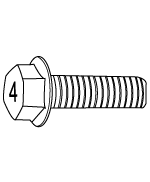 | 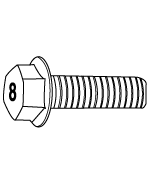 | 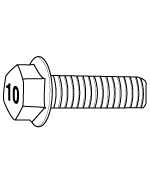 | |
M5 | 0.8 (0.031) | 2.0 ~ 2.9 (0.2 ~ 0.3, 1.4 ~ 2.2) | 5.9 ~ 7.8 (0.6 ~ 0.8, 4.3 ~ 5.8) | 8.8 ~ 11.8 (0.9 ~ 1.2, 6.5 ~ 8.7) |
M6 | 1 (0.039) | 3.9 ~ 4.9 (0.4 ~ 0.5, 2.9 ~ 3.6) | 9.8 ~ 13.7 (1.0 ~ 1.4, 7.2 ~ 10.1) | 14.7 ~ 19.6 (1.5 ~ 2.0, 10.8 ~ 14.5) |
M8 | 1.25 (0.049) | 8.8 ~ 11.8 (0.9 ~ 1.2, 6.5 ~ 8.7) | 24.5 ~ 32.4 (2.5 ~ 3.3, 18.1 ~ 23.9) | 35.3 ~ 48.1 (3.6 ~ 4.9, 26.0 ~ 35.4) |
M10 | 1.5 (0.059) | 17.7 ~ 24.5 (1.8 ~ 2.5, 13.0 ~ 18.1) | 48.1 ~ 65.7 (4.9 ~ 6.7, 35.4 ~ 48.5) | 70.6 ~ 96.1 (7.2 ~ 9.8, 52.1 ~ 70.9) |
M12 | 1.75 (0.068) | 31.4 ~ 43.1 (3.2 ~ 4.4, 23.1 ~ 31.8) | 84.3 ~ 113.8 (8.6 ~ 11.6, 62.2 ~ 83.9) | 123.6 ~ 167.7 (12.6 ~ 17.1, 91.1 ~ 123.7) |
M14 | 2 (0.078) | 51.0 ~ 68.6 (5.2 ~ 7.0, 37.6 ~ 50.6) | 135.3 ~ 182.4 (13.8 ~ 18.6, 99.8 ~ 134.5) | 198.1 ~ 268.7 (20.2 ~ 27.4, 146.1 ~ 198.2) |
M16 | 2 (0.078) | 79.4 ~ 107.9 (8.1 ~ 11.0, 58.6 ~ 79.6) | 212.8 ~ 288.3 (21.7 ~ 29.4, 157.0 ~ 212.7) | 311.8 ~ 421.7 (31.8 ~ 43.0, 230.0 ~ 311.0) |
Flange BOLT/NUT Thin screw | Torque Nm (kg.m, Ib-ft) | |||
Nominal diameter. (mm) | Pitch [mm (in.) ] | 4T | 8T | 10T |
 |  |  |  | |
M5 | 0.5 (0.019) | 2.9 ~ 2.9 (0.3 ~ 0.3, 2.2 ~ 2.2) | 6.9 ~ 8.8 (0.7 ~ 0.9, 5.1 ~ 6.5) | 9.8 ~ 13.7 (1.0 ~ 1.4, 7.2 ~ 10.1) |
M6 | 0.75 (0.029) | 3.9 ~ 5.9 (0.4 ~ 0.6, 2.9 ~ 4.3) | 10.8 ~ 14.7 (1.1 ~ 1.5, 8.0 ~ 10.8) | 16.7 ~ 21.6 (1.7 ~ 2.2, 12.3 ~ 15.9) |
M8 | 1 (0.039) | 9.8 ~ 12.7 (1.0 ~ 1.3, 7.2 ~ 9.4) | 26.5 ~ 35.3 (2.7 ~ 3.6, 19.5 ~ 26.0) | 38.2 ~ 52.0 (3.9 ~ 5.3, 28.2 ~ 38.3) |
M10 | 1.25 (0.049) | 19.6 ~ 25.5 (2.0 ~ 2.6, 14.5 ~ 18.8) | 51.0 ~ 68.6 (5.2 ~ 7.0, 37.6 ~ 50.6) | 75.5 ~ 102.0 (7.7 ~ 10.4, 55.7 ~ 75.2) |
M12 | 1.25 (0.049) | 35.3 ~ 48.1 (3.6 ~ 4.9, 26.0 ~ 35.4) | 94.1 ~ 126.5 (9.6 ~ 12.9, 69.4 ~ 93.3) | 138.3 ~ 186.3 (14.1 ~ 19.0, 102.0 ~ 137.4) |
M14 | 1.5 (0.059) | 55.9 ~ 75.5 (5.7 ~ 7.7, 41.2 ~ 55.7) | 148.1 ~ 200.1 (15.1 ~ 20.4, 109.2 ~ 147.6) | 216.7 ~ 293.2 (22.1 ~ 29.9, 159.8 ~ 216.3) |
M16 | 1.5 (0.059) | 86.3 ~ 116.7 (8.8 ~ 11.9, 63.7 ~ 86.1) | 229.5 ~ 309.9 (23.4 ~ 31.6, 169.3 ~ 228.6) | 336.4 ~ 455.0 (34.3 ~ 46.4, 248.1 ~ 335.6) |
The torques shown in the table are standard values under the following conditions.
Nuts and bolts are made of galvanized steel bar.
Galvanized plain steel washers are inserted.
All nuts, bolts and plain washers are dry.
The torques shown in the table are not applicable.
When spring washers, toothed washers and the like are inserted.
If plastic parts are fastened.
If self-tapping screws or self-locking nuts are used.
If threads and surfaces are coated with oil.
Parts | Specifications |
Engine oil | API Classification SG Above (SAE 10W/30, 5W/30) API Classification SH Above (SAE 7.4W/30) |
Manual transaxle | API Classification GL - 4 (SAE 75W/90) |
Automatic transaxle | GENUINE HYUNDAI transaxle oil, GENUINE DIAMOND ATF SP - III |
Brake | DOT 3 or DOT 4 |
Cooling system | High quality ethylene glycol - Concentration level 40% (tropical) - Concentration level 50% (tropical) |
Power steering | PSF - 3 |
Transaxle linkage, parking brake cable mechanism, hood lock and hook, door latch, seat adjuster, tailgate latch, door hinges, tailgate hinges | Multipurpose grease NLGI grade #2 |
Always use GL - 4 Classification for the manual transaxle (Do not use GL - 5 Classification)
Always use Genuine Hyundai parts and recommended fluid.
Using any other type of parts and fluid can cause serious damage of the vehicle.
Description | Capacities | |||
1.1 | 1.3 | 1.5/1.6 | ||
Engine oil | Oil pan | 2.8 (2.96, 2.46) | 3.0 (3.17, 2.64) | |
Oil filter | 0.2 (0.21, 0.18) | 0.3 (0.32, 0.26) | ||
Total | 3.0 (3.17, 2.64) | 3.3 (3.49, 2.90) | ||
Cooling system | 6.0 (6.34, 5.28) | 6.2 (6.55, 5.46) | 6.5 (6.87, 5.72) | |
Manual transaxle | 2.15 (2.27, 1.89) | 2.5 (2.27, 1.89) | ||
Automatic transaxle | - | 6.1 (6.45, 5.37) | ||
Power steering | 0.9 (0.95, 0.79) | 0.9 (0.95, 0.79) | ||
liter (U.S. qus., lmp.qts.) | ||||
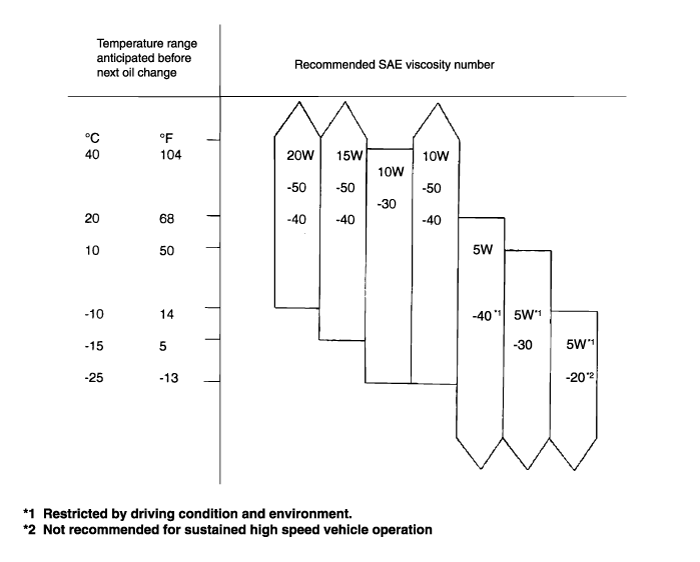
Satisfy the requirements of the API classification.
Have the proper SAE grade number for expected ambient temperature range.

Work must be started approx. 30 seconds or longer after the ignition switch is turned to the LOCK position and the negative (-) battery cable is disconnected. (The airbag system is equipped with a back - up power source.ive (-) battery cable is disconnected.
If work is started within 30 seconds when disconnecting the negative (-) battery cable of the battery, the airbag may be operative.)
When the negative (-) terminal cable is disconnected from the battery, the clock and audio systems memories will be erased. Before starting work, record the setting of the audio memory system
When work is finished, reset the audio system as before and adjust the clock.
Malfunction symptoms of the airbag system are difficult to comfirm, so diagnostic codes become the most important source of information when troubleshooting. When troubleshooting the airbag system, always read the diagnostic trouble coodes befroe disconnecting the battery.
Never use airbag parts from another vehicle. When replacing parts, replace them with new parts.
Never attempt to disassemble and repair the airbag modules, SRSCM, clock spring and Air - bag wiring harness in order to reuse it.
If the SRSCM or air - bag module have been dropped, or if there are cracks, dents or other defects in the case, bracket or connector, replace them with new ones.
After work on the airbag system is completed, reset the airbag warning lamp.
The support rod must be inserted into the hole near the edge of the hood whenever you inspect the engine compartment to prevent the hood from falling and causing possible injury.
Make sure that the support rod has been released prior to closing the hood. Always check to be sure the hood is firmly latched before driving the vehicle.
The following precautions must be followed when jacking up the vehicle.
Block the wheels.
Place a jack under the specified jacking point.
Support the vehicle with safety stands (jack stands) Refer to the page GI - 8.
Start the engine when engine compartment is clear.
Be sure that all necessary tools and measuring equipment are available before starting work.
Use special tools when they are required.
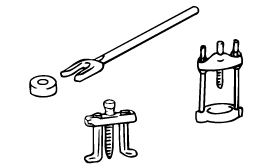
First find the cause of the problem and then determine whether removal or disassembly is required before starting the job.
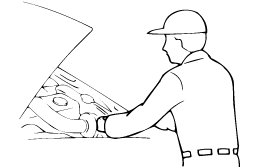
If the disassembly procedure is complex, requiring many parts to be disassembled, all parts should be disassembled in a way that will not affect their performance or external appearance.
Inspection of parts
Each part, when removed, should be carefully in spected for malfunction, deformation, damage, and other problems.
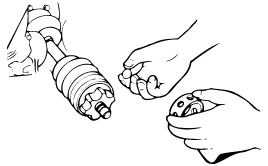
Arrangement of parts
All disassembled parts should be carefully arranged for effective reassembly.
Be sure to separate and correctly identify the parts to be replaced from those that will be used again.
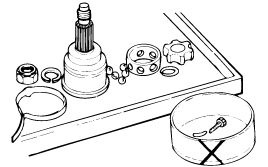
Cleaning parts for reuse
All parts to be used again should be carefully and thoroughly cleaned by an appropriate mathod.
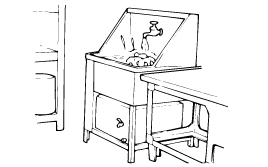
When replacing parts, use HYUNDAI genuine parts.
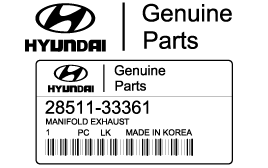

Standard values, such as torques and certain adjustments, must be strictly observed in the reassembly of all parts.
If removed, the following parts should always be replaced with new ones.
Oil seals
Gaskets
O-rings
Lock washers
Cotter pins (split pins)
Plastic nuts
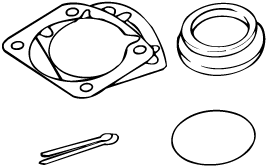
Selalant should be applied to gaskets.
Oil should be applied to the moving components of parts.
Specified oil or grease should be applied to the prescribed locations (oil seals, etc.) before assembly.
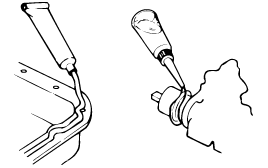
Use gauges and testers to adjust correctly the parts to standard values correctly.
Be sure to disconnect the battery cable from the negative (-) terminal of the battery.
Never pull on the wires when disconnecting connectors.
Locking connectors will click when the connector is secure.
Handle sensors and relays carefully. Be cardful not to drop them or hit them against other parts.
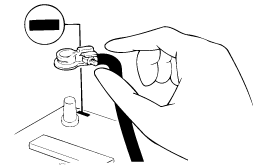
Always prevent gasoline or oil from touching rubber parts or tubing.

Basically, all measurements in this manual are taken with a tracking gauge.
When a measuring tape is used, check to be sure there is no elongation, twisting or bending.
For measuring dimensions, both projected dimensions and actual - measurement dimensions are used in this manual.
These are the dimensions measured when the measurement points are projected from the vehicle's surface, and are the reference dimensions used for body alterations.
If the length of the tracking gauge probes is adjustable, measure it by lengthening one of two probes as long as the different value in height of the two surfaces.

These dimensions indicate the actual linear distance between measurement points, and are used as the reference dimensions when a tracking gauge is used for measurement.
First adjust both probes to the same length (A=A') before measurement.
Check the probes and gauge itself to make sure there is no free play.
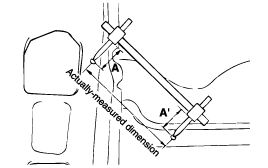
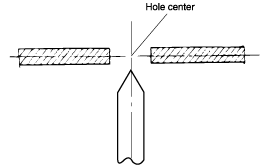
Check the terminal for tightness.
Check terminals and wires for corrosion from battery electrolyte, etc.
Check terminals and wires for open circuits.
Check wire insulation and coating for damage, cracks and degrading.
Check the conductive parts of terminals for contact with other metallic parts (vehicle body and other parts).
Check grounded parts to verify that there is complete continuity between thier attaching bolt(s) and the vehicle's body.
Check for incorrect wiring.
Check that the wiring is so clamped to prevent contact with sharp corners of the vehicle body, etc. or hot parts (exhaust manifold, etc.)
Check that the wiring is clamped firmly to provide enough clearance from the fan pulley, fan belt and other rotating or moving parts.
Check that the wiring has a little space so that it can vibrate between fixed and moving parts such as the vegicle body and the engine.
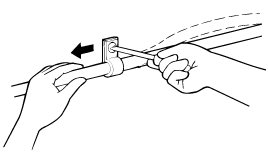
A blade type fuse has test taps provided to allow checking the fuse itself without removing it from the fuse bliock. The fuse is good if the test lamp lights up when one lead is connected to the test taps (one at a time) and the other lead is grounded. (Turn the ignition switch so that the fuse circuit becomes operative)
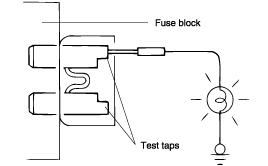
Prior to servicing the electrical system, be sure to turn off the ignition switch and disconnect the battery ground cable.
In the course of MFI or ELC system diagnosis, when the battery cable is removed, any diagnostic trouble code retained by the computer will be cleared. There fore, if necessary, read the diagnostic codes before removing the battery cable.

Attach the wiring harnesses with clamps so that there is no slack. However, for any harness which passes the engine or other vibrating parts of the vehicle, allow some slack within a range that does not allow the engine vibrations to cause the harness to come into contact with any of the surrounding parts, and then secure the harness by using a clamp.

If any section of a wiring harness interferes with the edge of a part, or a corner, wrap the section of the harness with tape or something similar in order to protect it from damage.

When installing any parts, be careful not to pinch or damage any of the wiring harnesses.
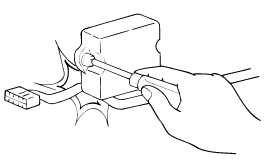
Never throw relays, sensors or electrical parts, or expose them to strong shock.

The electronic parts used in the computer, relays, etc. are readily damaged by heat. If there is a need for service operations that may cause the temperature to exceed 80°C (176°F), remove the electronicc parts beforehand.
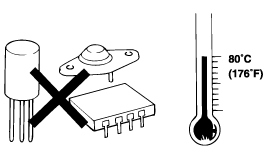
Loose connectors cause problems. Make sure that the connectors are always securely fastened.

When disconnecting a connector, be sure to grip only the connector, not the wires.
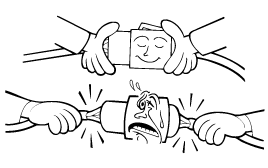
Disconnect connectors which have catches by pressing in the direction of the arrows shown the illustration.
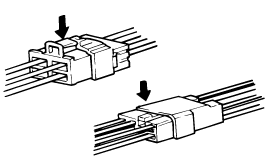
Connect connectors which have catches by inserting the connectors until they make a clicking sound.
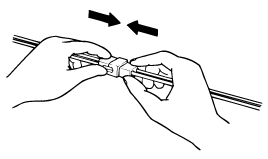
When using a circuit tester to check continuity or voltage on connector terminals, insert the test probe into the harness side. If the connecs a sealed connector, insert the test probe through the hole in the rubber cap until it contacts the terminal, being careful not to damage the insulation of the wires.
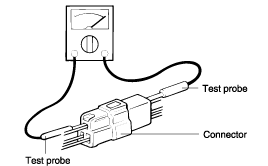
To avoid overloading the wiring, take the electrical current load of the optional equipment into consideration, and determine the appropriate wire size.
Norminal size | SAE gauge No. | Permissible current | |
In engine compartment | Other areas | ||
0.3 mm² | AWG 22 | - | 5A |
0.5 mm² | AWG 20 | 7A | 13A |
0.85 mm² | AWG 18 | 9A | 17A |
1.25 mm² | AWG 16 | 12A | 22A |
2.0 mm² | AWG 14 | 16A | 30A |
3.0 mm² | AWG 12 | 21A | 40A |
5.0 mm² | AWG 10 | 31A | 54A |
If a large amount of undurned gasoline flow into the covverter, it may overheat and create a fire hazard. To prevent this, observe the following precautions and explain them to your customer.
Use only unleaded gasoline.
Do not run the engine while the car is at rest for a long time. Avoid running the engie at fast idle for more than 10 minutes and at idle speed for more than 20 minutes.
Avoid spart-jump tests. Do spart-jumps obly when absolutely necessary. Perform this test as rapidly as possible andm, while testing, never race the engine.
Do not measure engine compression for and extended time. Engine compression tests must be made as rapidly as possible.
Avoid coasting with the ignition turned off and during prolonged braking.
Do not dispose of a used catalytic converter together with parts contaminated with gasoline or oil.
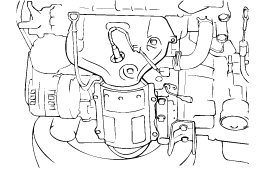
CHANGING ENGINE OIL
If the engine is cold, run the engine until it reaches normal operating temperature.
Turn off the engine.
Remove the oil filler cap and drain plug. Drain the engine oil.
Tighten the drain plug to the specified torque.
Tightening torque
Oil pan drain plug :
35 ~ 45 Nm (350 ~ 450 kg.cm, 25 ~ 33 lb.ft)

Whenever tightening the oil drain plug, use a new drain plug gasket.
Fill new engine oil through the oil filler cap opening.
Do not overfill, this will cause oil aeration and loss of oil pressure.
Install the oil filler cap.
Start and run the engine.
Turn off the engine and then check the oil level. Add oil if necessary.
Use a filter wrench to remove the oil filter.
Before installing a new oil filter on the engine, apply clean engine oil to the surface of the rubber gasket.
Tighten the oil filter to the specified torque.
Tightening torque
Oil filter : 12 ~ 16 Nm (120 ~ 160 kg.cm, 9 ~ 12 lb.ft)
Start and run the engine and check for engine oil leaks.
After turning off the engine, check the oil level and add oil as necessary.
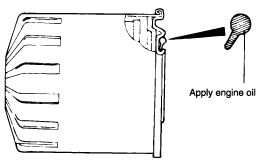
The air cleaner filter will become dirty during use and the filtering efficiency will be substantially reduced. Replace with a new one as needed.
Disconnect the clip holding air cleaner filter cover.
Remove the air filter cover.
Remove the air cleaner filter.
Install a newair cleaner filter and replace the air cleaner filter cover.
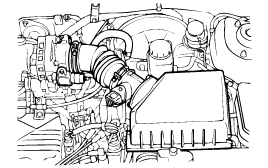
ADJUSTING BELT TENSION
Refer to EM and EMA-Sections.
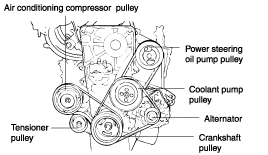
If the concentration of the antifreeze is below 30%, the anticorrosion property will be adversely affected. In additiom, if the concentration is above 60%, both the antifreeze and engine cooling properties will decrease,k adversely affecting the engine. For these reasons be sure to maintain the concentration level within the specified range.
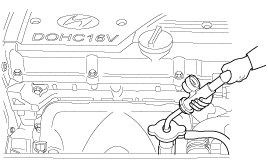
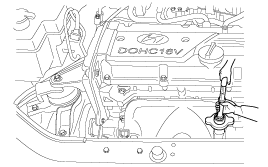
Set the temperature control lever to the hot position.
Remove the radiator cap.
Remove the cap slowly. The system is pressurized and the coolant may be hot. Do not open the cap when the engine is hot.
Loosen the drain plug to drain the coolant.
Drain the coolant from the reserve tank.
After draining the coolant, tighten the drain plug securely.
Fill the radiator with the coolant up to its filler neck.
Fill the reserve tank with coolant to the MAX. line.
Warm up the engine until the thermostat opens, remove the radiator cap and check the coolant level.
When the radiator is filled up to its filler neck, install the radiator cap securely.
Fill the reserve tank with coolant up to the "FULL" line.
When disconnecting an ignition cable, be sure to hold the cable cap. If the cable is disconnected by pulling on the cable alone, an open circuit might result.
The oxygen sensor is a device which helps control the fuel mixture. If the oxygen sensor is damaged, the exhaust-gas cleaning efficiency as well as driveability deteriorate. Therfore, it should be replaced periodically with a new one.

Inspect for leakage in each component and check the oil level by removing the filler plug. If the oil is contaminated, replace it with new oil.
With the vehicle parked on a level surface, remove the filler plug and make sure that the oil level is the same level as the plug hole.
Check that the transaxle oil is not dirty.
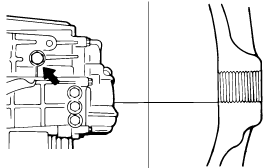
With the vehicle parked on a level surface, remove the magnetic plug to drain transaxle oil.
Replace the washer with a new one and reinstall the magnet plug.
Fill with transaxle oil (through the filler plug part) until the oil level is the same level as the plug hole.
Check the steering wheel freeplay.
Maximum steering wheel freeplay : 30 mm (1.181 in.)
Check the steering linkage for looseness and damage.
Tie rod ends must not have excessive play.
Dust seals and boots must not be damaged.
Boot clamps must be not loose.
Park the vehicle on a level surface, start the engine, and then turn the steering wheel several times to raise the temperature of the fluid to approximately 50°C (122°F).
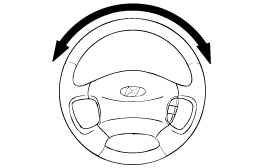
With the engine idling, turn the wheel all the way to the left and right several times. Check the fluid in the oil reservoir for foaming, and its level. Replenish the fluid in the oil reservoir through the oil filter if necessary.

Check the hose connections for fluid leaks.
The power steering hoses should be replaced if there is severe surface cracking, pulling, scuffing or worn steps. Deterioration of the hoses could cause premature failure.
These components, which are permanently lubricated at the factory, do not require lubrication. Damaged seals and boots should be replaced to prevent leakage or contamination of the grease.
Inspect the ddust covers and boots for proper sealing, leakage and damage. Replace them if defective.
Check all brake lines and hoses for damage, wear, cracks, corrosion, leaks, bends, twists.
Check all clamps for tightness.
Check that the lines are clear of sharp edges, moving parts and the exhaust system.
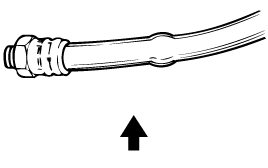
Check for fluid contamination and wear. Always replace brake pads in complete sets.
If a squealing or scraping noise occurs from the brake during driving, check if the pad wear indicator is contacting the disc, if it is, the brake pad should be replaced.
The pads for the right and left wheels should be replaced at the same time. Never split or intermix brake pad sets. All pads must be replaced as a complete set.
Thickness of pad lining [limit] : 2.0mm (0.079 in.)
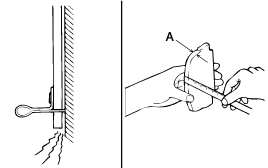
Remove the brake drum and check the thickness of the brake shoe lining for wear. Check the automatic brake adjusting system by hand to see that it operates smoothly and gears are in proper mesh to each other.
To assure smooth function, apply a very thin coat of grease to the friction surface of the adjuster and link shaft.
Inspect the wheel cylinder boots for fluid leaks. Visually check the boots for cuts, tears or heat cracks. (Asmall amount of fluid on the boot may not be a leak, but preservative fluid used at assembly.)
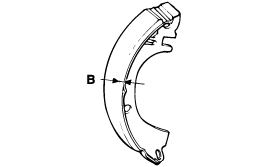
Check the level of the brake fluid in the reserve tank of the master cylinder.
The level should be between the "MAX" and "MIN" mark.
If the level is lower than the "MIN" mark, add fresh brake fluid up to the "MAX" mark.
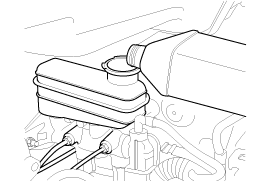
Refer to BR Section for air-bleeding procedures.
Connect a vinyl tube to the bleeder screw of each wheel cylinder. Put the other end of the vinyl tube in a vessel for receiving the brake fluid.
With a vehicle equipped with ABS (Anti-lock Brake System), refer to the BR-section.
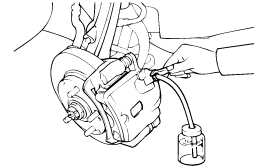
Depress the brake pedal a few times. Then loosen the bleeder screw (with the brake pedal still depressed), and tighten it after the brake fluid stops flowing.
Repeat the above operation until air bubbles are not in the brake fluid.
Repeat these steps for the other cylinders.
Add fresh brake fluid up to the "MAX" level in the reserve tank.
Brake fluid : DOT 3 or DOT 4
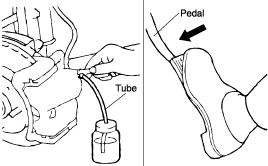
Tire Size | Tirepressure |
155/80 R13 | 30 PSI |
175/70 R13 | 30 PSI |
185/60 R14 | 30 PSI |
Check oil, fluid, fuel, water and exhaust gas leaks.
Check free play of clutch pedal and brake pedal.
Check the operation of brake booster.
Check the operation of service brake and parking brake systems.
Check the stroke of parking brake lever.
Check the driveability of engine.
Check the condition of instruments, gauges, indicators, exterior lamps, heater and ventilators.
Check for abnormal noises from each part.
